Hops in Beer Brewing: Amallia
Published: September 29, 2025 at 8:54:11 PM UTC
Amallia Hops, also spelled Amalia hops, are a new American hop variety. They originate from Neomexicanus hops found in New Mexico. In the United States, brewers are intrigued by their bold, earthy flavors and floral notes. This guide aims to assist homebrewers and craft brewers in making the most of Amallia hops. It covers flavor, chemistry, growing, and sourcing, ensuring informed recipe decisions.
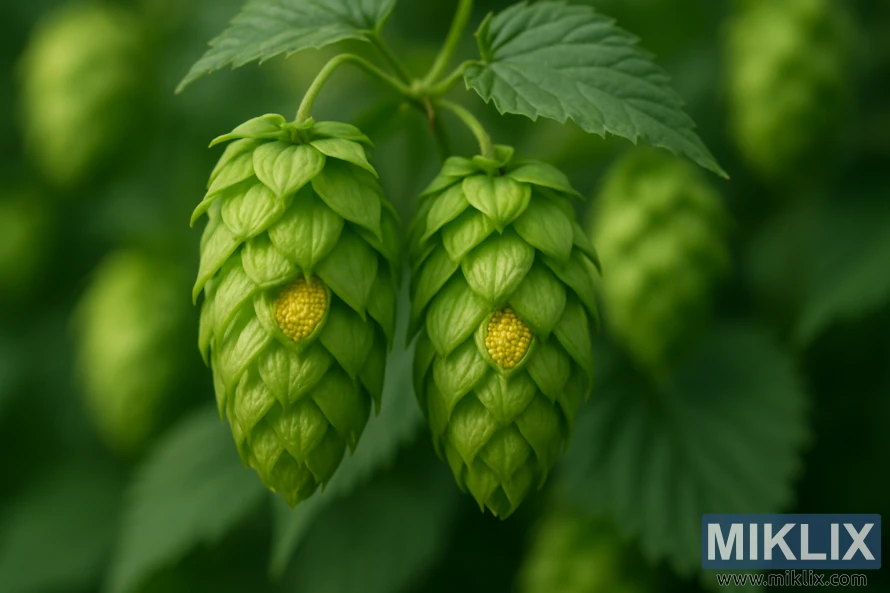
As a dual-purpose hop, Amallia is suitable for both bittering and aroma additions. It's ideal for pale ales, IPAs, and darker styles. This article will detail alpha and beta acid ranges, boil and whirlpool timings, dry hopping tips, and pairing suggestions. These insights will help you enhance your beer with Amallia Hops.
Key Takeaways
- Amallia Hops are a Neomexicanus-derived American hop with both bittering and aroma uses.
- Also known as Amalia hops, they bring earthy, resinous, and floral notes suitable for many ale styles.
- Use them across the boil, whirlpool, and dry hop for layered aroma and bitterness control.
- Pair Amallia with citrus-forward hops or classic U.S. varieties to balance resin and lift.
- Homebrewers can source Amallia locally or from specialty suppliers as availability grows.
Introduction to Amallia Hops and Their Brewing Potentials
Amallia, a newcomer to the hop scene, has its roots in native Humulus lupulus from New Mexico. Its origin stems from wild plants that breeders have carefully selected and stabilized. This background connects it to the broader family of Neomexicanus hops from the Southwest.
Neomexicanus hops have quickly transitioned from botanical curiosity to brewer interest. Growers like Eric Desmarais at CLS Farms and small-scale cultivators such as Todd Bates have made these plants accessible. Early commercial releases were available through outlets like Holy Hops at the Benedictine Monastery of Christ in the Desert.
The history of Amalia is marked by a mix of trials, hobby plots, and pilot batches, unlike the decades of commercial breeding typical of other hops. Sierra Nevada and other breweries tested Neomexicanus varieties in beers like Harvest Wild Hop IPA. These trials assessed the aroma and flavor impact, paving the way for limited commercial use.
Amallia is valued by brewers as a dual-purpose hop. It provides a bittering backbone and adds citrus, tangerine, floral, earthy, and minty notes when used later in brewing. This versatility makes New Mexico hops, including Amallia, appealing for pale ales, IPAs, brown ales, and experimental brews seeking a regional character.
The role of newcomer hop varieties like Amallia in a brewer's toolkit hinges on availability and creative intent. Small releases and trial packs allow brewers to experiment with blending Amallia with established varieties. Using Amallia can impart a distinct Southwestern flavor to beers, enriching them without overpowering the base malt or yeast character.
Amallia Hops Flavor and Aroma Profile
Amallia hops offer a distinct aroma, dominated by bright citrus. Tasters often detect tangerine and orange, which cut through malt and yeast. Late additions are key to preserving these oils.
The flavor profile also highlights floral earthy hops. Expect a wildflower-like bloom that remains natural, not perfumey. A desert-earth undertone adds a dry, grounded balance to the citrus.
Some batches introduce spicy hop notes and a faint minty twist. The spice can manifest as black pepper or clove, depending on the amount used. This slight menthol edge can enhance wheat beers and Hefeweizens without overpowering yeast esters.
Extraction methods significantly impact the aroma. Late boil, whirlpool, and dry hopping are best for preserving volatile oils like myrcene and humulene. These methods help retain the citrus tangerine and floral earthy hops characteristics.
It's important to use restraint to avoid an overripe or harsh orange tone. Amallia can become sharp if used excessively. Small, targeted additions are key to maintaining balance and highlighting the hop's nuanced spice and stone-fruit hints.
Brewers find Amallia versatile across various styles. American IPAs benefit from its bold citrus presence. Brown ales and darker beers gain subtle complexity from its floral earthy notes. Wheat beers, on the other hand, pick up refreshing spicy notes while preserving yeast-driven profiles.
Alpha and Beta Acid Profile for Amallia Hops
Amallia alpha acids generally fall in a moderate range. Initial reports indicated values around 4.5%, while later data revealed a range from 5.5% to 9.0%. Beer-Analytics suggests a common midpoint of 7% with a spread of 4.5 < 7.0 < 9.1. This range impacts bittering choices and the Amallia IBU contribution brewers can anticipate.
Amalia beta acids also show variability. Ranges span from about 4.2% to 8.3%, with many datasets clustering around 6.0%. Beta acid levels are critical for long-term stability and the hop's bitterness perception over time. This is important for beers aged on hops or kept in kegs for long periods.
Total oil content for Amallia is modest to moderate, usually between 1.0–1.6 mL/100g. This oil content supports strong late additions, where Amallia's hop chemistry expresses aroma most effectively. Key oil components include myrcene for juicy citrus notes, caryophyllene for spicy highlights, humulene for earthy character, and farnesene for a faint fruity-green nuance.
Practical application of these numbers is key. With moderate-to-high alpha, Amallia is suitable for early boil additions for bittering. Typical recommendations suggest 1–2 ounces per 5-gallon batch for primary bittering, adjusted for target IBUs and boil gravity.
For aroma and flavor, late kettle, whirlpool, and dry-hop techniques are preferred. These methods extract hop oils without losing delicate volatiles. When calculating Amallia IBU contribution, use the alpha midpoint as a baseline and adjust based on actual lab values for your lot.
Brewers should test small batches and adjust. The variability in Amallia alpha acids and Amalia beta acids means taste trials yield better results than relying on a single published number. Track lot-specific analysis when possible to refine bittering, aroma balance, and final beer stability.
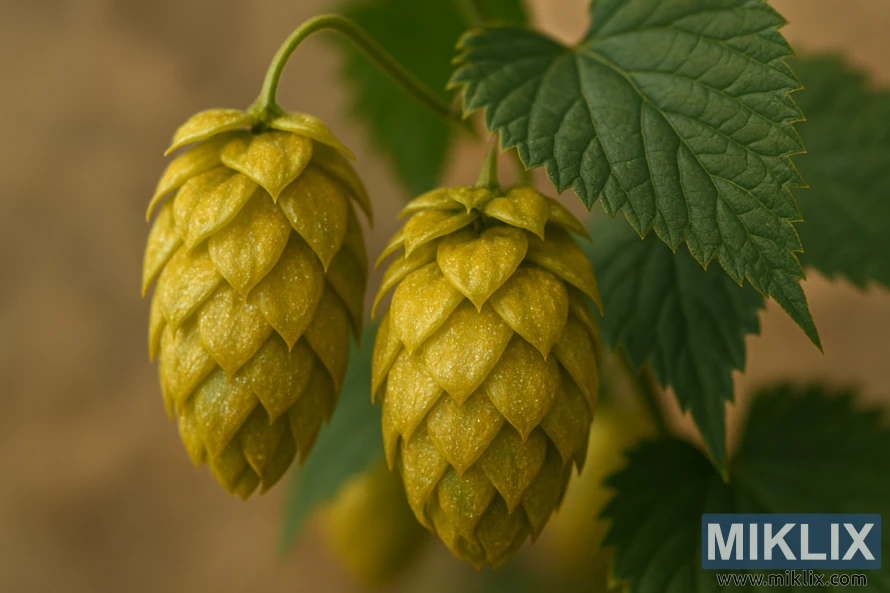
How to Use Amallia Hops in the Boil
Amallia is a versatile hop, suitable for both bittering and late additions. It provides clean bitterness when added early and adds bright citrus and floral notes when added later. This flexibility makes it ideal for a variety of brewing schedules.
For bittering, add 1–2 ounces per 5-gallon batch in the first 60 minutes. This amount ensures a balanced bitterness without overpowering the beer. It's perfect for pale ales, IPAs, brown ales, and stouts.
For mid-boil flavor, add 0.5–1 ounce with 15–30 minutes left. This approach captures more hop flavor and balances the malt character. It's suitable for saisons, wheat beers, and Belgian or experimental ales.
For late-boil aroma, use 0.5–1 ounce in the final 10–15 minutes. This method preserves volatile oils and enhances citrus and floral notes. Be cautious not to exceed the recommended amounts to avoid a harsh orange flavor.
Plan your hop additions to spread contributions throughout the boil. A common pattern includes early bittering, mid-boil flavor, and late aroma additions. Adjust the quantities based on the beer style and desired intensity.
- Early (60 min): 1–2 oz for base IBUs
- Mid (15–30 min): 0.5–1 oz for flavor
- Late (10–15 min): 0.5–1 oz for aroma
After boiling, consider whirlpooling at 170–180°F or cooler. This helps extract oils with less harshness. It complements whirlpool and dry-hop techniques, maximizing Amallia's contribution without adding bitterness.
Dry Hopping and Whirlpool Techniques with Amallia
Amallia dry hop and whirlpool methods bring out the bright, juicy hop character while minimizing harsh bitterness. Whirlpool hops are added at flame-out, and the wort is held at 160–180°F for 10–30 minutes. This favors the transfer of volatile oils. Cooler whirlpool temperatures and shorter contact times enhance floral and delicate citrus notes during Amalia aroma extraction.
For dry hopping, aim for 0.5–1 oz per 5-gal batch to boost aroma without overwhelming the beer. In hop-forward IPAs, total doses of 1–2 oz per 5-gal are common. Experienced brewers often recommend 0.5–2 oz ranges, depending on the beer style and desired intensity.
Timing is key. Late fermentation or post-fermentation dry hops preserve fragile aromatics best. When combining a robust Amallia whirlpool with dry hopping, reduce the dry hopping dosage to avoid over-extraction. Short contact times and gentle handling help keep oils bright and clean.
Handle Amallia with care. Its oil profile responds strongly to late additions but can develop vegetal or pithy notes if contact time or quantity is excessive. Monitor aromatic development and adjust future dry hopping dosage based on results.
- Whirlpool: add hops at flame-out, 10–30 minutes at 160–180°F for oil-focused extraction.
- Dry hop timing: late fermentation or post-fermentation to retain volatile aromatics.
- Typical dry hopping dosage: 0.5–1 oz per 5-gal for aroma; 1–2 oz for IPA intensity.
Recommended Dosage and Use by Beer Style
For a 5-gallon batch, Amallia dosage ranges from 0.5 to 2.0 ounces. A 0.5 ounce addition provides a subtle aroma, while 1–2 ounces offer noticeable bittering or a strong aroma. Many brewers prefer a 32% hop share when Amallia is a primary hop.
In American IPA brewing, start with 2 ounces early in the boil for bittering. Add an extra 1 ounce as a dry hop to enhance citrus-forward aroma. This balance ensures a classic IPA profile with both bittering and aroma.
Pale Ale recipes typically require 1–2 ounces total. Most additions should be late in the boil or at flameout to emphasize citrus and floral notes. This approach maintains a balance between malt and hops.
Brown ales and darker styles benefit from about 1 ounce as a late addition. This addition provides an earthy lift and faint citrus without overpowering roasted or caramel malts. Adjusting Amallia IBUs downward helps preserve malt balance.
For English-style ales, limit Amallia to about 0.5 ounce for a subtle presence. Use it as a gentle aroma complement to traditional English hops and malts. This low dosage ensures hop usage by style Amallia is suitable for classic drafts.
Hefeweizen and wheat beers can use 0.5 ounce to add a light spice accent. Place the addition late or in the whirlpool to avoid overpowering yeast-driven banana and clove esters. This small amount integrates well into wheat-centered Amalia recipes.
Belgian and experimental ales can use 0.5–1 ounce late or in the whirlpool. This range supplies layered complexity without dominating yeast character. Monitor Amallia IBUs if bittering additions are used alongside other hop varieties.
Practical tip: when building recipes, treat hop usage by style Amallia as flexible. Start with recommended dosages, then scale by batch size, target IBUs, and the hop profile of companion varieties. Small test batches help dial in the exact Amallia dosage for your preferred result.
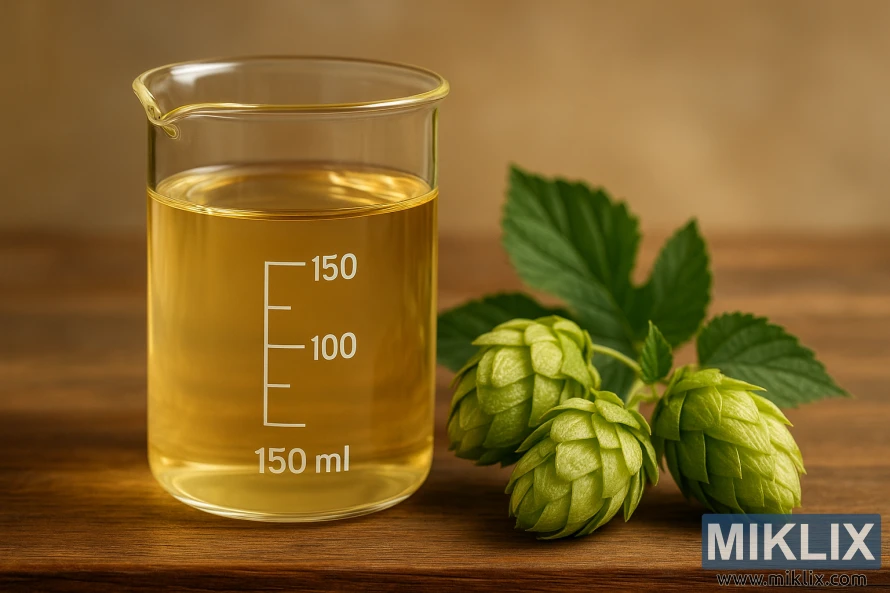
Pairing Amallia Hops with Other Hop Varieties
When pairing Amallia hops, match its floral and desert-earthy core with citrus, resin, and tropical characters. For bright, zesty beers, consider Citra, Amarillo, Motueka, or Mandarina Bavaria. These hops enhance Amallia’s tangerine notes.
To add backbone and bitterness contrast, use Chinook or Cascade. These hops bring pine, grapefruit, and classic American resin. They balance Amallia’s softer floral tones and sharpen the finish.
For juicy, fruit-forward layers, Mosaic, Galaxy, or El Dorado amplify stone fruit and tropical top notes. These hops are perfect in NEIPAs and single-hop experiments where texture is key.
For a more traditional or English-leaning profile, choose East Kent Golding. It tames citrus intensity while introducing gentle floral and herbal nuance. This is ideal for session ales and bitters.
- Blend approach 1: Amallia as dominant aroma hop with a classic bittering hop like Chinook for structure.
- Blend approach 2: Use Amallia as a mid/late addition to add citrus/floral nuance to existing hop blends Amalia brewers favor.
- Blend approach 3: Create hop blends Amalia-centric by pairing Mosaic or Citra for depth and Mandarina Bavaria for brightness.
Keep dosage modest when layering multiple expressive hops. This preserves clarity of Amallia’s signature notes while adding complexity. Small-scale trials reveal the best balance for each beer style.
Yeast Choices and Fermentation Considerations with Amallia
The selection of yeast significantly influences the presentation of Amallia hops in beer. American ale yeasts, such as Wyeast 1056 or Safale US-05, ferment cleanly. This allows hop oils to dominate the flavor profile. These strains are commonly chosen for IPAs and pale ales, where the focus is on hop-forward flavors.
English ale strains, like Wyeast 1968, introduce malt sweetness and esters. These elements soften the bright citrus notes from Amallia hops. Such yeast strains are ideal for brown ales or malty session beers, where balance is key.
Wheat and Hefeweizen yeasts, exemplified by Wyeast 3068, contribute clove and banana phenolics. A judicious amount of Amallia can introduce spicy, herbal complexity. This combination enriches the flavor profile, moving beyond the typical hop-forward beers.
- American ale strains — highlight hop aroma and keep a clean finish.
- English strains — add fruit and malt context to mellow citrus.
- Wheat/Hefe strains — contribute phenolics that play with Amallia spice.
Technique during fermentation is critical for preserving aroma. Minimizing oxygen exposure during dry-hopping protects delicate hop volatiles. Many brewers add hops after primary fermentation or during terminal fermentation for optimal aroma preservation.
Cold crashing and short dry-hop windows are effective in maintaining bright top notes. Active fermentation can strip away volatiles, so consider biotransformation for modified aromas. Yet, avoid prolonged exposure to prevent oxidation.
Recent trends indicate a preference for clean, well-attenuating yeasts with Amallia. This approach ensures that hops remain clear and expressive. When experimenting, document yeast strains and fermentation conditions. This will help track how these factors impact the final aroma.
Recipe Ideas and Example Formulations Using Amallia
Start with a 5-gallon Amallia single-hop beer to explore its range. Use 10–11 lb Pale Ale malt as the base. Add 2 oz Amallia at 60 minutes for bitterness, 1 oz at 10 minutes, and 1 oz in the whirlpool. Finish with 1 oz as a dry hop. This combination results in moderate IBUs and a strong hop aroma.
For a malt-forward brown ale, begin with 10 lb Maris Otter or amber malts. Incorporate 1 oz Amallia at 15 minutes and another 1 oz late in the whirlpool. Choose an English ale yeast to enhance citrus and earthy notes, balancing the malt.
A Hefeweizen benefits from a lighter touch. Mix 50% wheat malt with pilsner for the base. Add 0.5 oz Amallia at 5–10 minutes or 0.5 oz as a dry hop. Select a hefe yeast to achieve a banana and clove flavor that complements the hop's subtle spice.
To craft a hop-forward IPA, start with about 11 lb pale malt. Use 1.5–2 oz Amallia at 60 minutes for bitterness, 1–2 oz in the whirlpool, and 1–2 oz as dry hops. Blend Amallia with Citra or Mosaic to layer tropical fruit over its citrus profile.
- Single-hop Pale Ale (5 gal): Base malt 10–11 lb Pale Ale malt, Amallia 2 oz at 60 min, 1 oz at 10 min, 1 oz whirlpool, 1 oz dry hop.
- Brown Ale accent (5 gal): Maris Otter/amber 10 lb, 1 oz Amallia at 15 min, 1 oz late whirlpool, English ale yeast.
- Hefeweizen touch (5 gal): 50% wheat malt, 0.5 oz Amallia at 5–10 min or 0.5 oz dry hop, hefe yeast.
- IPA forward (5 gal): Pale malt 11 lb, 1.5–2 oz Amallia at 60 min, 1–2 oz whirlpool, 1–2 oz dry hop; blend with Citra/Mosaic.
Many brewers adapt Amalia homebrew recipes, adjusting hop percentages. Beer-Analytics reveals Amallia often makes up about 32% of the hop bill when it's the star. Feel free to tweak this ratio to suit your taste, whether you want Amallia to lead or support other hops.
When adapting these templates, consider the timing for bittering versus aroma hops. Use Amallia single-hop beer trials to fine-tune its bitterness and aroma balance. Keep detailed records of hop weights, times, and yeast strains to refine each batch reliably.
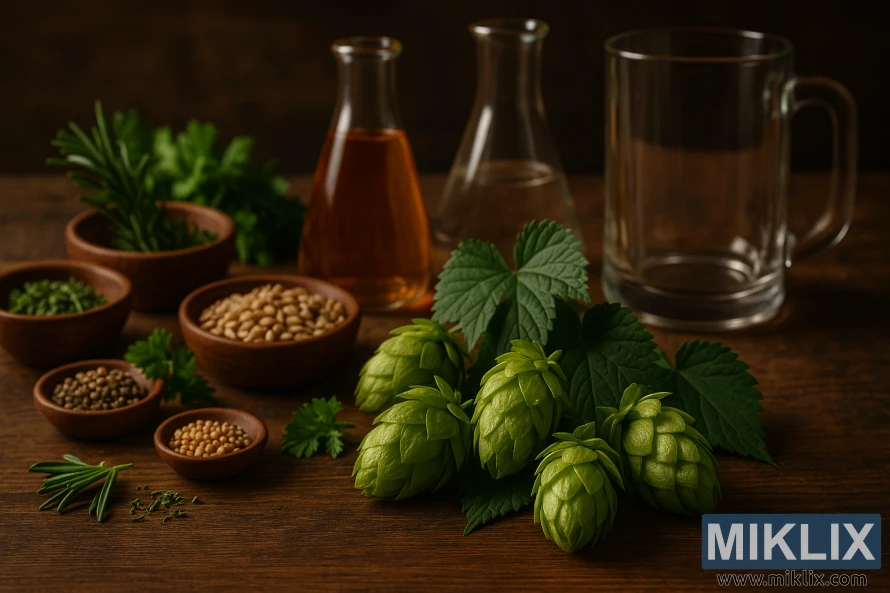
Comparing Amallia to Other Hops and Neomexicanus Varieties
Amallia stands out with its unique blend of citrus, orange blossom, and floral notes. It also has a rustic, slightly minty edge. Compared to American favorites like Cascade, Citra, and Amarillo, Amallia feels less refined but more untamed. It's seen as less tropical than Citra and less citrusy than Amarillo.
When comparing Amalia to Cascade, you'll notice a richer herbal and desert flavor profile. Cascade is known for its clear grapefruit and floral zest. Amallia, on the other hand, adds earthy undertones and a hint of tangerine, all wrapped in a refreshing minty aroma.
Against noble hops like Saaz and Spalt, Amallia is more assertive. These hops offer delicate spice and a noble perfume. Amallia, as an American dual-purpose hop, balances aroma with bitterness, making it versatile in brewing.
In the realm of Neomexicanus varieties, Amallia shares a unique regional character. Chama, Latir, Mintras, Tierra, and Multihead each bring their distinct flavors: Chama is citrusy and herbal, Latir spicy floral, Mintras herbal and minty, Tierra a mix of mint and citrus, and Multihead floral and peachy.
- Alpha ranges: Amallia's alpha acids vary from about 4.5% to near 9%. Chama and Latir have mid-sevens, while Mintras and Tierra are lower.
- Flavor cues: Amallia often presents tangerine and orange with a subtle mint lift. Mintras and Tierra focus more on mint.
- Usage: Amallia is great for single-hop showcases or blends with Citra or Amarillo to enhance fruit notes.
The brewing implications of Amallia are clear. It's perfect for creating beers that feel grounded yet wild. It can replace or complement classic American hops, adding new aromatic dimensions. For those exploring Neomexicanus varieties, blending Amallia with Chama or Latir showcases citrus and herbal contrasts while maintaining a balanced alpha profile.
Sourcing Amallia Hops and Availability for Homebrewers
Amallia hops initially emerged as a rare find from Holy Hops, a Benedictine Monastery in the Desert. Early batches quickly sold out, leaving a trail of eager homebrewers. Today, finding these hops in retail pellets remains a challenge. Availability hinges on the success of seasonal harvests and occasional trial releases.
Commercial breweries like Sierra Nevada, Schlafly, and Crazy Mountain have showcased neomexicanus varieties in small batches. These limited releases spark interest but do not ensure a steady supply for homebrewers looking to buy Amallia hops.
For better luck, homebrewers should explore specialized hop retailers and small hop farms. These sources often list their seasonal offerings. Fresh-hop releases and direct connections with Holy Hops Amalia are the most reliable indicators of availability.
Homebrew shops can facilitate pre-orders or provide access to rhizomes and crowns for those who wish to grow their own plants. It's essential to inquire about the lot data and alpha/beta specifications to align with your brewing goals.
- Search specialty hop merchants during harvest season.
- Contact Holy Hops Amalia listings for limited runs.
- Ask local homebrew stores about pre-orders or rhizomes.
- Compare clone names and alpha/beta numbers before you buy Amallia hops.
Be cautious of spelling variations like Amalia and Amallia, as well as different clones. Always verify packet data. If you're unsure about where to buy Amallia hops, request lot sheets or sample notes from retailers. These will help confirm the aroma and oil content.
Availability can fluctuate annually, so it's wise to plan ahead and secure pre-orders when possible. Persistence and direct communication with small farms or Holy Hops can often lead to securing Amalia availability for your next brewing project.
Growing and Cultivating Amallia Hops for Brewers
Homebrewers often opt to cultivate Amallia hops from Amalia rhizomes or small crowns. It's essential to start with disease-free material from a trusted source. Planting in spring allows vines to establish before the heat intensifies.
Neomexicanus hops thrive in warm, dry environments with full sun exposure. They naturally flourish in climates like New Mexico. Even in cooler regions, selecting the sunniest, driest spot and protecting plants from moisture excess can lead to success.
The type of soil is critical. Sandy loam or loamy sand ensures good drainage, which is vital for preserving alpha acid levels. During the growing season, maintain consistent moisture levels to prevent root rot. Mulching helps retain moisture and suppress weeds without compromising drainage.
Proper trellising and maintenance are essential for high yields. Use robust posts and durable wire or twine for the bines. Train shoots early, pinch to promote lateral growth, and prune to control vigor. Regularly inspect for pests and mildew to ensure marketable cones.
Timing of harvest significantly impacts the aroma and bittering qualities of the hops. Amallia hop farming requires tasting and testing small batches to track alpha and beta acid variations. These values change with the season, clone, and location, so it's important to document results to refine future plantings.
- Planting: spring, full sun, 3–4 feet between crowns.
- Watering: consistent but well-drained; avoid standing water.
- Support: trellis to 12–18 feet for optimal cone production.
- Testing: small harvests to evaluate alpha levels before large-scale use.
For those who grow Amallia hops at home, diligent care transforms Amalia rhizomes into reliable cone producers. Thoughtful cultivation of Neomexicanus hops and practical farming practices ensure quality from the backyard to the brew kettle.
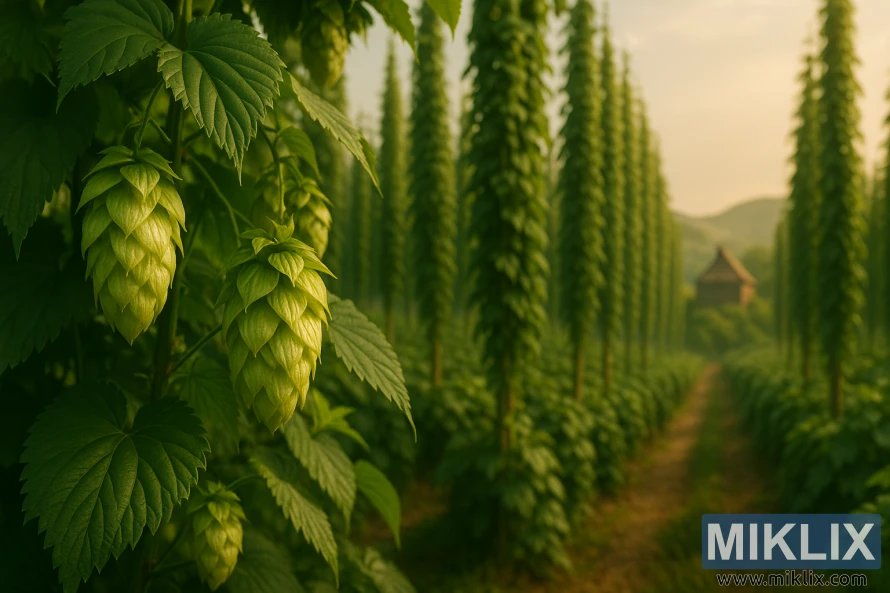
Common Brewing Challenges and Troubleshooting with Amallia
Amallia hops introduce bold citrus and tropical flavors, but brewers often encounter issues. These can arise from excessive late additions or high dosages, leading to harsh orange or pithy bitterness. To address this, brewers should reduce the amount of hops added in late stages. It's also beneficial to use cooler whirlpool temperatures. This helps preserve delicate oils without extracting too much bitterness.
Vegetal or grassy off-notes can occur due to long contact times at high temperatures. To resolve this, shorten the whirlpool time and prefer dry-hopping at cooler fermenter temperatures. This approach ensures cleaner aromatics and maintains the bright fruit character without introducing green flavors.
Neomexicanus-derived hops, like Amallia, often exhibit lot-to-lot variability. Before scaling a recipe, it's essential to check the supplier's lot analysis for alpha, beta, and oil content. Adjusting bittering additions or aroma weights based on these numbers helps manage flavor swings and tackle Amalia hop problems in sensitive styles.
Supply inconsistency poses challenges for both commercial and home brewers. To mitigate this, keep a backup blend ready, such as Amarillo with Citra. This blend can mimic Amallia's citrus and tropical profile when batches are unavailable. Storing a reserve of pellets or having alternate suppliers can also reduce the need for last-minute substitutions and Amallia brewing issues.
In delicate beers, a strong Amallia character can overpower yeast esters or malt nuances. For styles like saisons, pilsners, or amber ales, use conservative dosages. This allows malt and yeast to take center stage. If a sample tastes overly hop-forward, consider splitting dry-hop additions across sessions or reducing whirlpool additions. This helps better integrate hops with the base beer.
- Quick checklist to troubleshoot Amallia: verify lot analysis, reduce late-hop weight, lower whirlpool temp, shorten contact time, and consider staged dry-hops.
- When replacing Amallia, test Amarillo+Citra blends in small 1–3 gallon batches to match aroma and bitterness before scaling.
- Record each trial’s temps, times, and weights to build a reliable profile for future brews.
Flavor Pairings and Serving Suggestions for Amallia-Forward Beers
Pair citrus and floral Amallia hops with foods that are bright and acidic. Citrus cheeses, ceviche, and seafood with lemon or orange salsa complement the hop's tangerine notes. These pairings enhance aroma and refresh the palate between sips.
For spicy dishes, select bold flavors that can stand up to the hop's bitterness. An American IPA with Amallia is great with spicy tacos, buffalo wings, and citrus-marinated grilled shrimp. The heat reveals herbal and minty notes in Amallia.
Richer, malt-forward dishes are ideal when Amallia is used as an accent. Brown ales or dark beers with Amallia pair well with roasted pork, mushroom ragout, and aged cheddar. The hops' desert-earthy undertone complements sweet malt without clashing.
Light wheat styles with Amallia are perfect for simple, fresh dishes. Wheat or Hefeweizen with Amallia touches work well with citrus salads, soft cheeses, and lightly spiced seafood. These pairings highlight floral back-notes while keeping the meal light.
- American IPA with Amallia: spicy tacos, buffalo wings, citrus-marinated shrimp.
- Brown/Dark ale with Amallia accent: roasted pork, mushroom dishes, aged cheddar.
- Wheat/Hefeweizen with Amallia touch: citrus salads, soft cheeses, light spicy fare.
Serve hoppy Amallia-forward beers cool but not freezing. Aim for 45–52°F to allow volatile aromatics to express themselves. Use a tulip or IPA glass to concentrate the nose and retain head for aroma release.
When serving Amalia beer, provide short tasting notes to guide guests. Describe the beers as bright tangerine and citrus on top, floral in the middle, and desert-earthy below. Mention possible minty or herbal nuances. Clear Amallia tasting notes help servers and drinkers make informed food choices.
Plan pairings for a tasting flight by ordering beers from lightest to most robust. Begin with wheat or pale ales, then IPAs, and finish with darker beers that feature Amallia as an accent. This sequence showcases the hop's range and keeps flavors distinct.
Conclusion
This Amallia summary focuses on a Neomexicanus hop from New Mexico. It offers moderate alpha acids and a complex oil profile. Expect citrus and tangerine notes with floral, earthy, and minty accents. This makes Amallia perfect for brewers aiming for a unique aroma in IPAs, pale ales, and experimental saisons.
When brewing with Amalia, treat it as a dual-purpose hop. Use it for balanced bitterness in early additions. Reserve whirlpool and dry-hop additions for aroma. Dosages range from 0.5–2 oz per 5-gallon batch, depending on style and desired intensity. Lot-to-lot variability is common, so start with a light hand and adjust in subsequent batches.
Sourcing Amallia can be challenging and seasonal. Look to specialty suppliers and local growers. Some homebrewers grow rhizomes when available. Blend it with Citra, Amarillo, Mosaic, or Chinook for layered complexity. Choose yeast strains that preserve citrus and floral esters. In conclusion, run small trials to fine-tune timing and dosage. Let the hop's nuance guide your recipe choices.
Further Reading
If you enjoyed this post, you may also like these suggestions:
